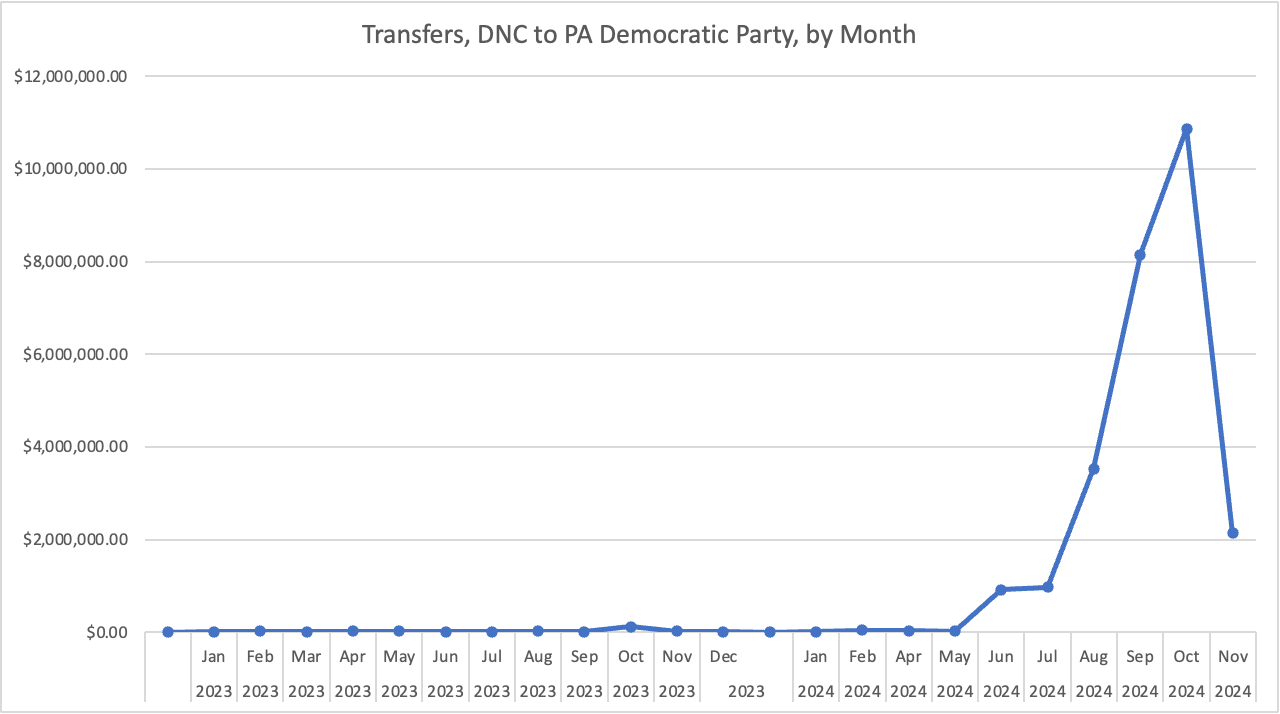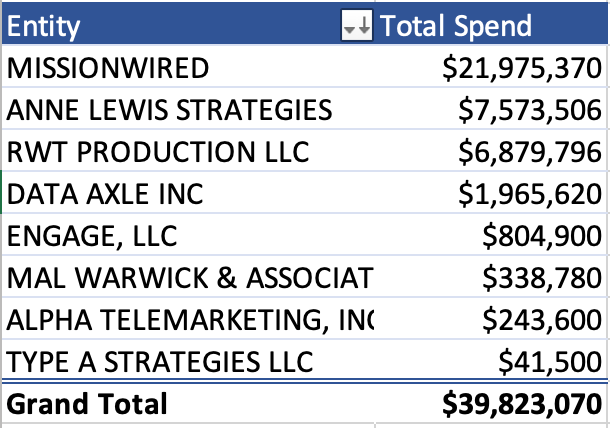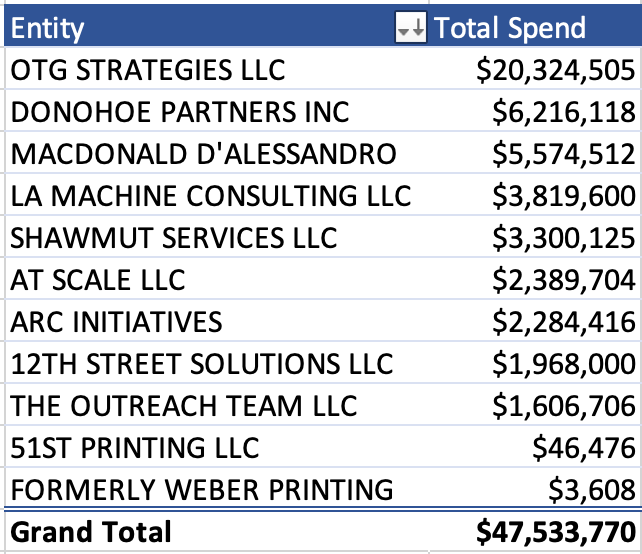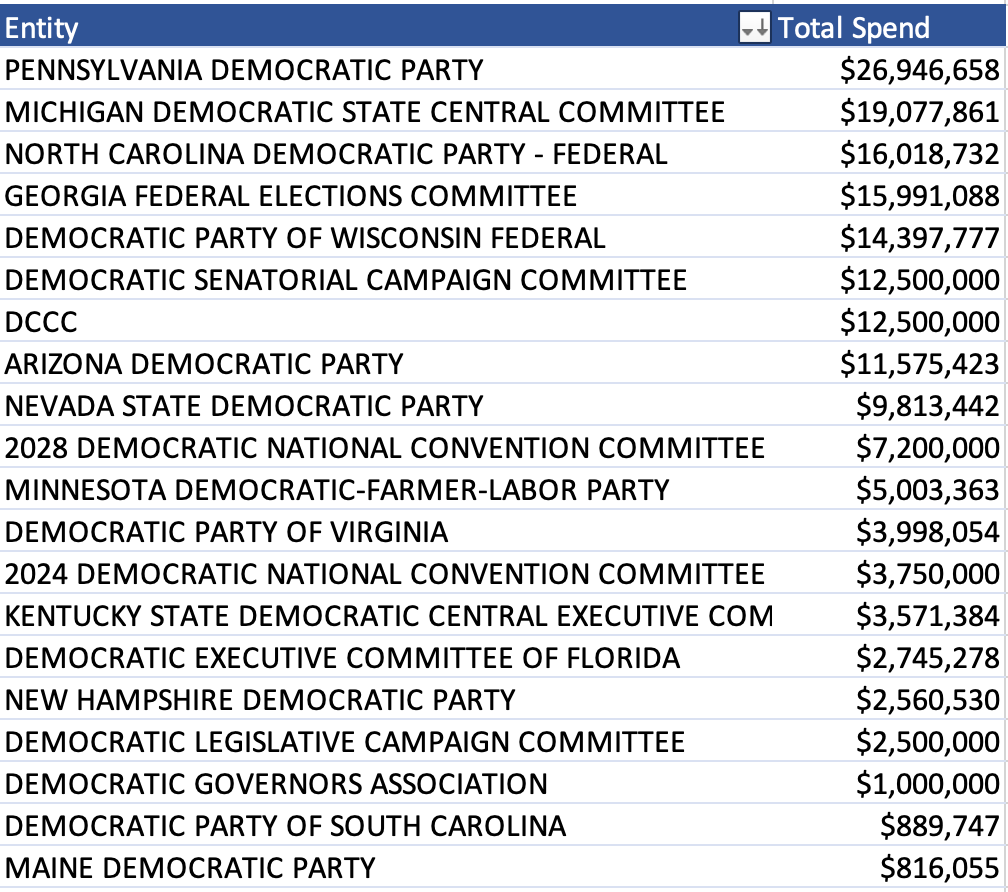What Did The DNC Do This Cycle?
Examining yet more FEC filings
I have, of course, been watching the DNC chair race. It’s impossible to avoid it on twitter right now. Given that I’m not a DNC member and not affiliated with the campaign for any given chair, I have no special insight into the race itself. What has been bothering me is the use of “the DNC” as a generic stand in for “the Democratic party”, with no consideration being given to what the organization actually does.
I would love to see a deeply reported story on what the DNC mechanically does, and how that’s changed over the years. My understanding, as someone who’s worked in politics for a while, is that the DNC is mostly a large bureaucracy and not exactly the ideological vanguard people are making it out to be, and I would love to have public information to point to for that conclusion.
Instead, here is something easily knowable about the DNC: where they spend money!
The DNC reports spending 635 million dollars in the ‘23/’24 cycle. This is less than a billion dollars, and spread out over more races, but still a *lot* of money. Since my last piece talked about how FEC filings worked, this one will not as much, go back and look at that one if you’re interested. There is much more accounting complexity happening in this filing, which I will try to point out where I can. It’s possible I am misunderstanding some of the sources of funds, since there’s a lot of transferring between different accounts reported in this filing and I am not an accountant or a lawyer.
Raising
The DNC’s money mostly came from transfers from other committees. About 200 million of it came from individual contributions or committee contributions, but 291 million came from “transfers from other committees”. There’s another chunk, about 137 million, that seems to be payments for various services and equipment, including recounts, convention services, etc.
The transfers from other committees are from the Presidential campaign victory funds, and then all the various state parties (I cut this screenshot off for sanity, but be assured it keeps going).
Spending
Here are the 20 top types of spending (I had to do a little cleanup on the transfer categorization, but that was all aesthetic and not substantive)
Transfers are a giant portion of the budget, with direct spending on what you’d call campaign activity (canvassing, mail, texts, etc) being much smaller shares.
The transfers between various types of account seem to mostly be for accounting reasons? I’m not totally sure what the net spend outside the organization is with these transfers, so I wouldn’t take these numbers as total gospel. However, I’m mostly interested in order-of-magnitude information, so we’re good.
Spending by Recipient
The biggest recipient of DNC money is....the DNC.
Accounting! This is aggregate spend, so there’s a lot of money going back and forth hiding in these numbers. I am going to guess someone will want to be annoying about this so: no, this is not evidence of “paying themselves” or another other grift, this is what happens to your account when you’re trying to be in compliance with campaign finance laws.
Next up, we have the PA Democratic party.
There are benefits to being a crucial swing state.
What’s up with that data services subscription charge? Is the DNC paying PA for data services? Not quite. If you look at the individual transactions, this is a monthly charge for the same amount. And if you further go look at the specific file image for one of those transactions, it’s marked as memoed. If you then page back through a bunch of other memoed nearly identical transactions to other state parties, you eventually find the entry describing those memoed transactions.
It’s an in-kind of a subscription to NGP Van! A little forward from that, you can find very similar records of in-kinded subscriptions to EveryAction marked as “software”. These two charges, for data services and software, are reflected for every state party.
[Note: memo items are typically part of another transaction, which can be confusing and lead you to double count expenditures. In this case, the filing has a record of both paying NGP Van for a service, and then a record of donating that service to each state party, which is recorded as an “in kind donation” even though no additional money has been spent.]
The “transfers” give us no other information, since they’re just that- transfers of funds. One interesting piece is you can see the dramatic spike in spending in October of 2024.
Looking at the PA Dem party’s similar filing, it looks like those transfers got mostly spent on advertising through SKDK, but we can’t know specifically. I did have a fun time scrolling through their filing- they seem to take a lot of Ubers for work.
Direct Outreach Spending
Mail
The next largest recipient of funds is MissionWired, a mail firm. In a fun quirk, someone has typoed some entries leading them to be categorized as “Driect Mail”, which initially messed up my table and dropped about a million dollars of spend from the Mail category in the table above.
If you fix that and aggregate all direct mail spending, you get about 40 million dollars in mail spending. That’s both a lot of money and not a lot of money when stacked up next to the total spend. You may recall that direct mail didn’t even appear in the top categories in the Harris filing. They only reported $199k in various mail services, a tiny portion of the budget. It looks like a lot of the mail going to various states this cycle was running either through the DNC or through state parties.
Canvassing
This is FAR more paid canvassing than the 8 million or so the Harris campaign put in. I would take this as yet more evidence of spending specialization (which is good!), where you run TV ads through the entity that can do them most cheaply (the campaign) and everything else through the DNC. Unfortunately, I do not love to see this much paid canvassing! I would keep an eye on this number in the coming years, especially as the various DNC candidates talk a big game about returning to on the ground politics. Ramping up paid canvassing can look like a good ground game, but it’s really not.
I don’t know what’s up with “Formerly Weber Printing” there, I’m guessing someone had a name change.
Text Messaging
Like the Harris campaign, a chunk of money was spent on text outreach. In this case, it’s about 16 million dollars, mostly running through Scale to Win. I don’t know how the content of these texts breaks down, but I’m going to guess it’s a lot of fundraising.
These three categories give you $103,571,918 in what I would consider to be “direct voter outreach”, around 16% of the total budget. There’s a further roughly 10 million in digital ads, and 6.5 million in online fundraising. This is a massive pile of money, but still smaller than the direct pass through transfers to state parties and committees.
More on Transfers
Where’d all that pass through money go? Here’s the top 20 recipients of money marked as Transfer.
This is a real who’s who of swing states. States vary in their campaign finance laws (and in how useful their state party is), so this likely does not perfectly reflect prioritization of states in the 2024 election.
You can also see 12.5 million to the DSCC, the same to the DCCC, followed by a pretty tragic and small 2.5 million to the DLCC and 1 million to the DGA. I know it was a big federal year, but ouch.
Jumpscare, one of those transfers was for the 2028 convention. Please no, too soon.
What About Consultants?
A moderate amount of hay has been made of the DNC’s supposed massive giveaways to consultants, with DNC Chair Candidate Ben Wikler promising a review of all consulting contracts on day one. With the acknowledgement that any half-competent accountant could hide a consulting expense from me (mark it as a distribution for services from a firm, etc), here’s everything explicitly marked as some type of consulting in the DNC disbursements.
Is that a lot of money? Kind of, I certainly don’t have 10 million dollars kicking around. Compared to the total budget of the DNC, is that a lot? Not particularly! Each of these types of consulting has a pile of different vendors contained within it, so it’s even more of a diffuse spend than it initially looks.
I suppose you can argue that all these consulting costs should be to in-house staff instead, but that would really misunderstand how people in and around Democratic politics work. If you’re someone with expertise in a particular area, it’s a hard sell to go work full time at an organization that’s probably going to fire you at the end of the cycle. It’s preferable to work part time for a number of organizations, usually via a consulting practice, and have both more flexibility and things like continuity of healthcare. You could probably eliminate the use of “consultants” if you really wanted, but I don’t think that would do much. We could also try and stop having such boom and bust employment cycles and doing things like laying off most of the DNC staff after a presidential year, but perhaps that’s a bridge too far.
Okay, one minor note: There’s a $2,000 “communications consulting” expense to “REPLY GUYZ LLC DBA ORGANIZER MEMES”. Is this...twitter account Organizer Memes? If it is, that’s both very funny, and doesn’t seem to have done literally anything to stop them shit-talking Democrats constantly.
What does the DNC do?
In purely monetary terms, mostly move money around to states and committees, with a sideline in direct mail, canvassing, texts, and other media. Oh, and pay for lawyers- there’s like 33 million in legal expenses that I didn’t cover because frankly I have no idea who most of these law firms even are or what they specialize in. They also do things like pay for software and data centrally and distribute them to state parties. Does this describe an organization in a position to drive the direction of the party? Maybe, in theory a lot of that flows from decisions made by state parties and in the primaries. But it doesn’t really describe an organization with that as a main goal, and it’s dwarfed by the spending and media of a presidential campaign.
I’d love to see DNC chair race coverage that started asking candidates about specific DNC expenditures- please, give me your opinion on centralized software purchasing, or on text vs digital fundraising. I find the use of the DNC chair race as a generic ideological fight really boring. If you’re auditioning to run a bureaucracy, I would like to see your thoughts about how to do that efficiently!
As before, if you want to dig into this more and you’re a journalist, happy to help. Probably even if you’re not a journalist, I think FEC filings are neat.













Thanks for the breakdown, it's always interesting to compare what an organization does compared to what people think it does.